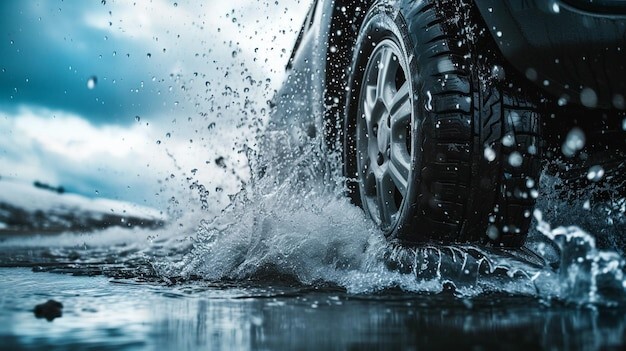Wet conditions and roads significantly reduce tire grip due to several factors:
1. Skidding: When there is a layer of water on the road, the tires can lose contact with the road surface and ride on the layer of water instead. This is called hydroplaning, which dramatically reduces road contact and control.
2. Speed: High speed increases the likelihood of hydroplaning. Water depth: Even a thin layer of water can cause loss of communication at high speeds. Tire tread: Worn or poorly designed tread patterns are less effective at channeling water.
3. Reduced Friction, Why this happens: Wet surfaces have less tire grip than dry surfaces because water acts as a lubricant, reducing the friction between the tires and the road. As a result: Braking distances are longer and cornering control is reduced.
4. Temperature Effects: Wet roads are often cooler, which can lower tire temperatures. Tires become ineffective at low temperatures because the rubber compounds cannot achieve optimal flexibility.
5. Road Contaminants: Rainwater mixes with oil, mud, and other substances on the road to form a slippery film that further reduces control.
6. Tread Design and Depth Tread Importance: Tire treads are designed to keep water away from road contact. If the tread is worn or unsuitable for wet conditions, the tires will not be able to make effective contact with the road.
7. Legal and Practical Tread Depth: A minimum of 1.6mm tread depth is required by law in most regions, but 3mm or more is recommended for safety in wet conditions.
8. Effect on driving dynamics: On wet roads, the stopping distance is significantly increased and, as a result, the tires are more prone to slip during turns or sudden maneuvers.
Tips to improve handling in wet conditions:
• Use tires designed for wet weather.
• Maintain proper tire pressure; underinflated or overinflated tires reduce control.
• Slow down in wet conditions to reduce the chance of skidding. Regularly check the tread depth and replace tires if necessary.
2. Speed: High speed increases the likelihood of hydroplaning. Water depth: Even a thin layer of water can cause loss of communication at high speeds. Tire tread: Worn or poorly designed tread patterns are less effective at channeling water.
3. Reduced Friction, Why this happens: Wet surfaces have less tire grip than dry surfaces because water acts as a lubricant, reducing the friction between the tires and the road. As a result: Braking distances are longer and cornering control is reduced.
4. Temperature Effects: Wet roads are often cooler, which can lower tire temperatures. Tires become ineffective at low temperatures because the rubber compounds cannot achieve optimal flexibility.
5. Road Contaminants: Rainwater mixes with oil, mud, and other substances on the road to form a slippery film that further reduces control.
6. Tread Design and Depth Tread Importance: Tire treads are designed to keep water away from road contact. If the tread is worn or unsuitable for wet conditions, the tires will not be able to make effective contact with the road.
7. Legal and Practical Tread Depth: A minimum of 1.6mm tread depth is required by law in most regions, but 3mm or more is recommended for safety in wet conditions.
8. Effect on driving dynamics: On wet roads, the stopping distance is significantly increased and, as a result, the tires are more prone to slip during turns or sudden maneuvers.
Tips to improve handling in wet conditions:
• Use tires designed for wet weather.
• Maintain proper tire pressure; underinflated or overinflated tires reduce control.
• Slow down in wet conditions to reduce the chance of skidding. Regularly check the tread depth and replace tires if necessary.
